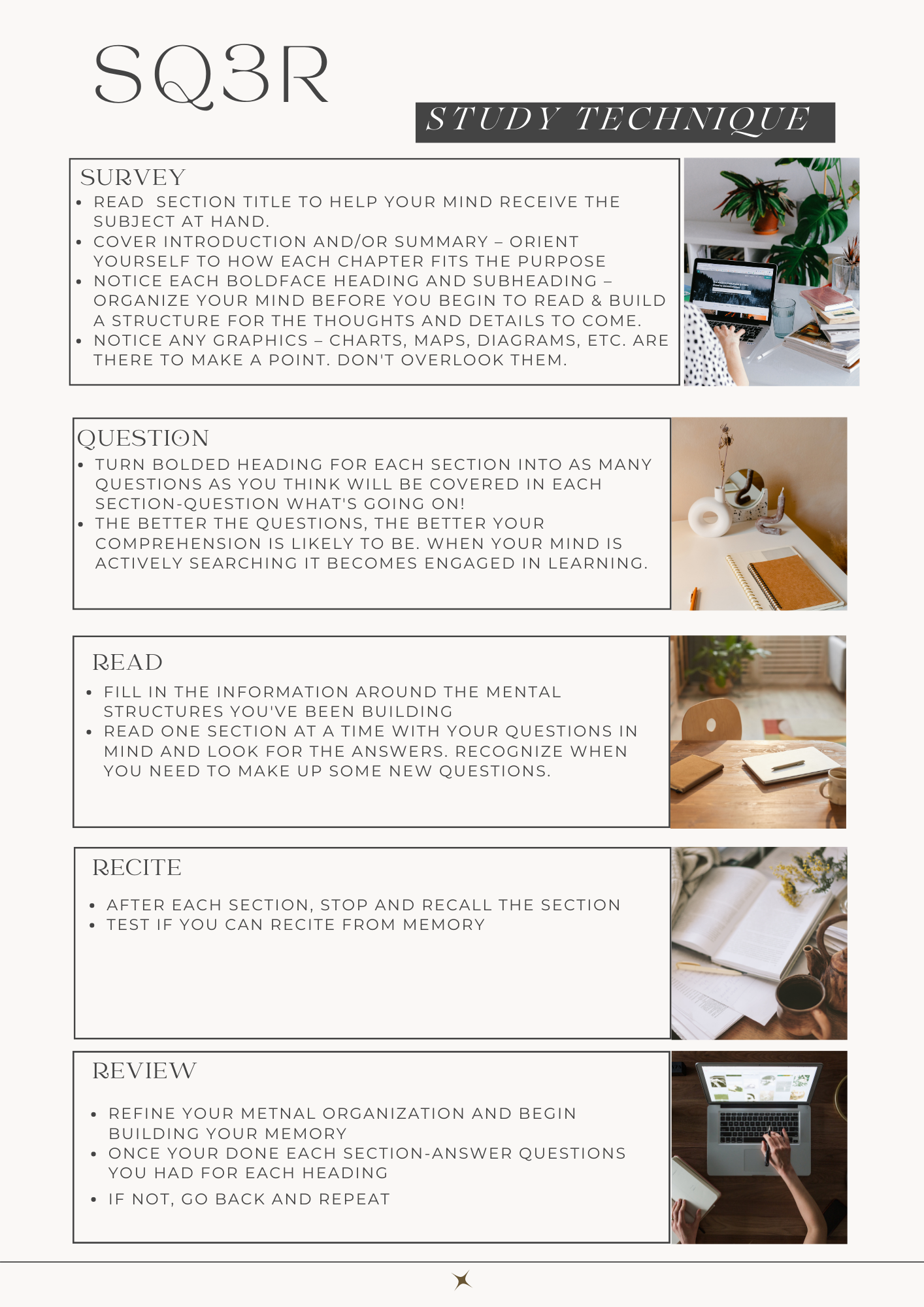How to study more effectively-Introducing SQ3R Method
We’ve all been there when we feel like we’ve studied hard, spent a lot of time and effort, along with probably a few late nights yet aren’t seeing results or the ones you expected. You probably feel burnt out from studying, or like something you’re doing isn’t working. Have you been there before?
Understand, don’t memorize
So, today we are going to talk about study management tips to help you improve your results and will help you study more effectively.
But, how do you do that?
Through the SQ3R method! Let’s deep dive and discuss how to use it.
SQ3R Method Overview
As a learner, the SQ3R study method works because it actively engages the reader in the learning process, encouraging them to survey, question, read, recite, and review the material. Instead of passively reading and memorizing the information, you as the reader are actively seeking out information and trying to understand it. The method encourages the reader to summarize and review what they have learned, which helps to consolidate long-term memory.
What is s-q-3-r stand for?
Let’s break it down! The SQ3R method is a reading comprehension technique that helps learners identify important facts and retain information from the material you’re are learning. As we mentioned above, SQ3R has 5 areas.
Survey: Instead of reading the entire book, start by skimming the first chapter and taking notes on any headings, subheadings, images, or other standout features like charts. Or even keywords that stand out a lot.
Question: Formulate questions around the chapter’s content, such as, What is this particular about? What do I already know about this subject? What can I piece together that shows an understanding of the section I’ll be learning
Read: Begin reading the full chapter and look for answers to the questions you formulated.
As you go reading, you’ll find keywords, graphics, or sections that will help you either elaborate on your original thoughts but also key areas so you can start filling out what you knew, to what it is.
Recite: After reading a section, summarize in your own words what you just read. Try recalling and identifying major points and answering any questions from the second step.
Review: Once you have finished the chapter, it’s important to review the material to fully understand it. Quiz yourself on the questions you created and re-read any portions you need to.
Key Area to note before you start taking notes
Messy notes can make it hard to recall the important points of a lecture. Writing in color is a dynamic way to organize the information you’re learning. It also helps you review and prioritize the most important ideas.
A recent study found that color can improve a person’s memory performance. That same study found that warm colors (red and yellow in particular)
“can create a learning environment that is positive and motivating that can help learners not only to have a positive perception toward the content but also to engage and interact more with the learning materials.”
It also reported that warmer colors “increase attention and elicit excitement and information.” Interesting right? I love how our brain works!
Writing in specific colors helps your brain remember that certain colors mean certain things. Test it out at home!
Write down key points in red.
Highlight important information in yellow
Organize topics by color
Don’t color everything—just the most important information.
I honestly didn’t learn these techniques in an educational environment (school or university). Learning how to learn is a skill you develop yourself and need to refine to what suits you best. One last tip I’ll leave you with is when learning, try to best ensure you’re actively studying instead of passively studying 📚
Active studying is more effective than passive studying for understanding and retaining information and studying only for exams leads to forgetting information.
Passive studying vs Active studying?
Passive studying is an approach where the learner engages in minimal effort without trying to actively understand concepts and apply them.
Examples
Reading textbooks or notes without highlighting, summarizing, or taking notes
Watching educational videos or lectures without actively taking notes or pausing to reflect on the information.
Reviewing flashcards without actively recalling the information or testing oneself
Active Studying
Helps promote better comprehension, retention, and development of critical thinking skills but most importantly sticks that information to your brain.
Let’s check out some examples!
Examples of Active Strategies
Explain material in your own words, speak it aloud
Formulate and write down questions as you read
Answer practice questions and seek to do additional practice questions/problems
Relate theories to real-life examples, interests, or stories
Develop a concept map or flow chart to organize material
Break diagrams down into smaller parts to explain how each part of the process works together
Participate in group discussions and group study sessions
Supercharge Your Studies
Effective studying requires active engagement, effective time management, and a variety of learning methods. By implementing these techniques, you can enhance your understanding, retention, and overall academic performance. As you adapt this study technique tailor it to your individual learning. Experiment with different strategies to find what works best for you. Good luck with your studies.
Until next time!



